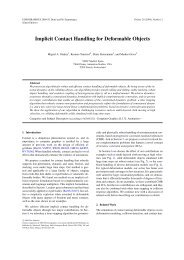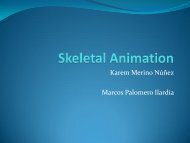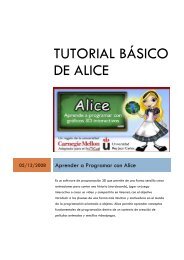Perceiving affordances in virtual reality: Influence of person ... - GMRV
Perceiving affordances in virtual reality: Influence of person ... - GMRV
Perceiving affordances in virtual reality: Influence of person ... - GMRV
You also want an ePaper? Increase the reach of your titles
YUMPU automatically turns print PDFs into web optimized ePapers that Google loves.
the perception: at the beg<strong>in</strong>n<strong>in</strong>g, the VE as a new environment <strong>in</strong>volves a safety<br />
first effect with an underestimation <strong>of</strong> action possibilities. But dur<strong>in</strong>g time and<br />
practice <strong>in</strong>side the VE, participants become more adapted and confident with a<br />
<strong>virtual</strong> perception reach<strong>in</strong>g the real perception. And f<strong>in</strong>ally, participants adopt<br />
risky and dangerous behaviors lead<strong>in</strong>g to an overestimation <strong>of</strong> action possibilities.<br />
Thus, it would be <strong>in</strong>terest<strong>in</strong>g for the future research to consider the time factor <strong>in</strong><br />
order to test this hypothesis. It is important to notice that previous studies have<br />
shown that distances appear to be compressed <strong>in</strong> immersive <strong>virtual</strong> environments<br />
presented via head mounted display systems, relative to <strong>in</strong> the real world<br />
(Ste<strong>in</strong>icke et al. 2009). Thus, the underestimation observed <strong>in</strong> our study could<br />
<strong>in</strong>dicate that the perception <strong>of</strong> <strong>affordances</strong> <strong>in</strong> VR would be also affected by the<br />
effect <strong>of</strong> compression. On the other hand, it is possible that some properties <strong>of</strong> the<br />
HMD configuration were <strong>in</strong>volved <strong>in</strong> this perception. These topics could be<br />
<strong>in</strong>vestigated more precisely <strong>in</strong> future experimental work.<br />
The aim <strong>of</strong> Experiment 2 was to evaluate the role <strong>of</strong> VE properties <strong>in</strong> perceiv<strong>in</strong>g<br />
<strong>affordances</strong> by manipulat<strong>in</strong>g the texture <strong>of</strong> the slanted surface. In this experiment,<br />
the participant adjusted the angle <strong>of</strong> <strong>in</strong>cl<strong>in</strong>ation <strong>of</strong> the <strong>virtual</strong> slanted surface until<br />
he (she) felt that it was just barely possible for him (her) to stand on that surface<br />
with a normal upright posture. The analysis showed that the perceptual boundary<br />
with the Ice texture (22.13°) was significantly lower than with the Wooden texture<br />
(27.60°). Thus, this result revealed that the <strong>virtual</strong> <strong>in</strong>formation about friction was<br />
detected and used <strong>in</strong> VE. Participants were able to differentiate visually a lowfriction<br />
texture (Ice) from a high-friction texture (Wooden). In other words, this<br />
result <strong>in</strong>dicated that the texture <strong>of</strong> the slanted surface was <strong>in</strong>volved <strong>in</strong> perceiv<strong>in</strong>g<br />
<strong>affordances</strong> for stand<strong>in</strong>g on this surface <strong>in</strong> VR. It suggests that participants can be<br />
<strong>in</strong>fluenced by the properties <strong>of</strong> the <strong>virtual</strong> environment (here the visual textures),<br />
and can extract and use such <strong>in</strong>formation when perceiv<strong>in</strong>g <strong>affordances</strong> <strong>of</strong> <strong>virtual</strong><br />
objects. Furthermore, as <strong>in</strong> the previous works conducted <strong>in</strong> real environments,<br />
our results also revealed that the perceptual boundaries occurred at steeper<br />
angles <strong>of</strong> <strong>in</strong>cl<strong>in</strong>ation on descend<strong>in</strong>g trials than on ascend<strong>in</strong>g trials. This f<strong>in</strong>d<strong>in</strong>g<br />
demonstrates a phenomenon known as enhanced contrast (Richardson et al. 2007)<br />
and suggests that perception <strong>of</strong> <strong>affordances</strong> <strong>in</strong> this task is a dynamical process.<br />
This last result re<strong>in</strong>forces the similarity observed between the perception <strong>of</strong><br />
<strong>affordances</strong> <strong>in</strong> VE and <strong>in</strong> real environments.<br />
22





